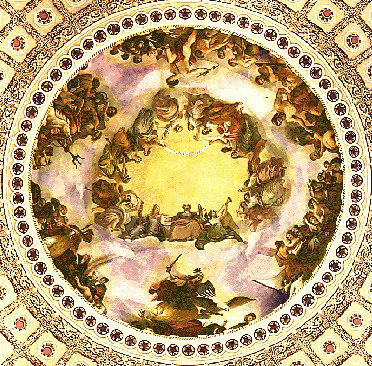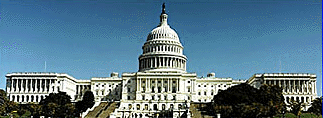


Five years ago, the country marked the 200th
anniversary of Washington's death on December 14, 1799. It was not surprising
that this anniversary did not have the dramatic and far-reaching effect
that it did on people two hundred years ago. To get some idea of how Washington's
death was regarded in the 19th century, take a close look at the painting
above. It is called "The Apotheosis of George Washington". It was painted
on the inside of the dome of the Capitol building in Washington, D.C.,
by Constantino Brumidi in 1865. Below
it, in the large round space known as the 'rotunda', are the five famous
paintings of John Trumbull. Thus, once inside the rotunda, you are not
only surrounded by Washington as the central figure in Trumbull's paintings,
Washignton also hovers above you, like an angel, in Brumidi's painting.
Here Washington is shown sitting in majesty, flanked on the right by the
Goddess of Liberty and on his left by a winged figure of Fame sounding
a trumpet and holding a palm frond aloft in a symbol of victory. Thirteen
women stand in a semi-circle around Washington, representing the thirteen
original states. On the outer ring of the canopy, six allegorical groupings
surround him, representing classical images of agriculture, arts and sciences,
commerce, war, mechanics, and the sea.
Below
it, in the large round space known as the 'rotunda', are the five famous
paintings of John Trumbull. Thus, once inside the rotunda, you are not
only surrounded by Washington as the central figure in Trumbull's paintings,
Washignton also hovers above you, like an angel, in Brumidi's painting.
Here Washington is shown sitting in majesty, flanked on the right by the
Goddess of Liberty and on his left by a winged figure of Fame sounding
a trumpet and holding a palm frond aloft in a symbol of victory. Thirteen
women stand in a semi-circle around Washington, representing the thirteen
original states. On the outer ring of the canopy, six allegorical groupings
surround him, representing classical images of agriculture, arts and sciences,
commerce, war, mechanics, and the sea.

 Revised
June 9, 2002
Revised
June 9, 2002